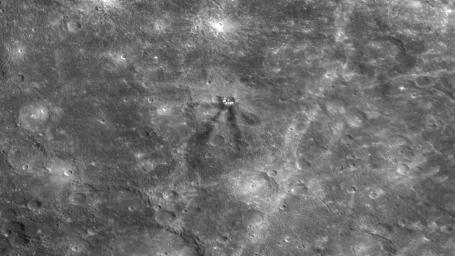
|
Matabei’s Unusual Dark Rays
- Click the image above for a larger view
- Full-Res JPEG (1920 x 1080) (278.5 kB)
- Full-Res TIFF (1920 x 1080) (2.1 MB)
Caption:
When a meteoroid strikes the surface of a planet, material from the target area is ejected outward at high velocity, often creating rays that extend over distances far greater than the size of the crater formed by the impact. During MESSENGER's second Mercury flyby , MDIS captured images of many impressive rays on Mercury, such as the ejecta prominent around Kuiper crater and the extensive ray system associated with the northerly Hokusai crater . For both of those examples, the rays appear bright, which is characteristic of freshly pulverized rock and indicates that the rays are younger than much of Mercury's surface. In contrast, in the center of this image, a set of dark rays can be seen emanating from the small crater Matabei . Dark rays are rare on Mercury, but other occurrences have been identified, such as at Mozart crater . Mozart is interpreted to have excavated dark material from depth during the impact event, creating dark streamers. The dark rays from Matabei may have a similar origin, and color images to be obtained during MESSENGER's orbital mission phase will be used to explore further the nature of these unusual dark rays.
Date Acquired:
October 6, 2008
Instrument:
Narrow Angle Camera (NAC) of the Mercury Dual Imaging System (MDIS)
Scale:
Matabei is 24 kilometers (15 miles) in diameter
Background Info:
These images are from MESSENGER, a NASA Discovery mission to conduct the first orbital study of the innermost planet, Mercury. For information regarding the use of images, see the MESSENGER image use policy .
Cataloging Keywords:
| Name | Value | Additional Values |
|---|---|---|
| Target | Mercury | |
| System | ||
| Target Type | Planet | |
| Mission | MESSENGER | |
| Instrument Host | MESSENGER | |
| Host Type | Orbiter | |
| Instrument | Mercury Dual Imaging System (MDIS) | |
| Detector | Narrow Angle Camera (NAC) | |
| Extra Keywords | Crater, Grayscale, Impact | |
| Acquisition Date | ||
| Release Date | 2010-09-14 | |
| Date in Caption | 2008-10-06 | |
| Image Credit | NASA/Johns Hopkins University Applied Physics Laboratory/Carnegie Institution of Washington | |
| Source | photojournal.jpl.nasa.gov/catalog/PIA13476 | |
| Identifier | PIA13476 | |
